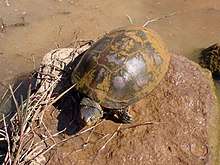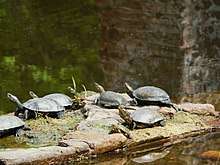European pond turtle
| European pond turtle | |
|---|---|
 | |
| Scientific classification | |
| Kingdom: | Animalia |
| Phylum: | Chordata |
| Class: | Reptilia |
| Order: | Testudines |
| Family: | Emydidae |
| Subfamily: | Emydinae |
| Genus: | Emys |
| Species: | E. orbicularis |
| Binomial name | |
| Emys orbicularis (Linnaeus, 1758) | |
 | |
| The range of the European pond turtle. | |
| Synonyms[2] | |
| |
The European pond turtle (Emys orbicularis), also called the European pond terrapin, is a long-living freshwater species[3] of turtle.
Subspecies
- Emys orbicularis capolongoi – Sardinian pond turtle
- Emys orbicularis colchica – Colchis pond turtle
- Emys orbicularis eiselti – Eiselt's pond turtle
- Emys orbicularis fritzjuergenobstii – Obst's pond turtle
- Emys orbicularis galloitalica – Italian pond turtle
- Emys orbicularis hellenica – Western Turkey pond turtle
- Emys orbicularis hispanica – Spanish pond turtle
- Emys orbicularis iberica – Kura Valley pond turtle
- Emys orbicularis lanzai – Corsican pond turtle
- Emys orbicularis luteofusca – Central Turkey pond turtle
- Emys orbicularis occidentalis – North African pond turtle
- Emys orbicularis orbicularis – Common European pond turtle
- Emys orbicularis orientalis – Suedkaspi pond turtle
- Emys orbicularis persica – Eastern pond turtle
Geographic range
It is found in southern and central Europe, West Asia and North Africa. In the early post-glacial period, the pond turtle had a much wider distribution, being found as far north as southern Sweden. It became extinct in Great Britain due to climate change.


Europe
In France, there are six large remaining populations, all deteriorating; it is the most endangered reptile of the country.[4]
In Switzerland, the European pond turtle was extinct at the beginning of the twentieth century and reintroduced since 2010.[4]
Habitat
Emys orbicularis turtles prefer to live in wetlands surrounded by a large proportion of natural, wooded, landscape. Specimens of Emys orbicularis are also found in upland environments for feeding.[5] Emys orbicularis is usually considered semi-aquatic, as their terrestrial movements can span 1000 meters, and occasionally found traveling up to 4000 meters, away from the water.[5]
Human impact
Historically, Emys orbicularis had been maintained as pets; however, this practice has been prohibited due to protection laws. Due to human impact, turtles have been found to be relocated in areas distant from their origin. However, it is possible to localize and indicate a region of origin with genetic testing.[6]
Appearance

The European pond turtle is a medium size turtle and varies quite a bit across its distribution, from 12 to 38 cm length. Its shell is brown with a hint of green, spotted yellow.
Morphology
An important factor that affects Emys orbicularis development is temperature and thermal conditions. It has been reported that differential growth rates of the same species occur, including variation of body size and clutch sizes, because of varying temperatures in certain areas.[7] Due to evident patterns of sexual dimorphism, Emys orbicularis adult males are always found to be smaller than females. In males, smaller plastrons offer them a wider mobility compared to females. In females, due to their differential diet and foraging habits, there may be a correlation to an adaptive effect on their skull and head morphology.[7]
Diet
Emys orbicularis turtles eat a mixed diet of plants and animal matter that can increase the efficiency of their digestive process. Although it is assumed that Emys orbicularis turtles are strictly carnivorous, it seems that not all Emys orbicularis are entirely carnivorous as their diet also consists of plant material.[5] It has been reported that an adult's diet starts from a carnivorous to a more herbivorous diet as it ages and grows in size. This is also very similar to other omnivore Emydidae turtles.[5] As an Emys orbicularis turtle grows in age and becomes an adult the amount of plant material consumption increases during the post breeding period. Emys orbicularis turtles may prefer less energetic food after the breeding season, a period of time where most of its energy is spent to recover from reproduction.[5]
Nesting

Most freshwater turtles lay their eggs on land, typically near a water body, but some species of Emys have been found to lay their eggs distances less than 150 meters from water.[3] The search of a nesting areas by adult females can last several hours to more than one day. Once the location of the nest is established, females spend time for the construction of the nest, laying of the eggs, and closing the nest which can take up to another 4 hours.[8]
Nest fidelity is a characteristic that female European pond turtles carry out by selecting a nesting site based on its ecological characteristics and then return there for future expeditions so long as the site has not changed.[3] Emys orbicularis females tend to change to another nesting site if there are visible changes to the present environment or because of dietary changes. If an Emys orbicularis female must change from nest to nest, it will typically select a site in close proximity.[3] In addition, females can also lay eggs in an abandoned nesting site if the conditions change to become better suited for egg survival. If the ecological characteristics of the nesting site changes, this may influence the survival of the hatchlings and their sex ratio. Due to ecological changes such as trees growing to shade the nest, this can change the environment into an inadequate location for egg incubation. Females that do not exhibit nesting fidelity and lay eggs in the same area for long periods of time, even with the ecological changes, may produce large proportions of males as vegetation grows and nesting areas become more shaded.[3] Since the sex of these turtles are temperature-dependent, a change in temperature may produce a larger number of males or females which may upset the sex ratio.[3]
Mortality
Climate has an effect on the survival of Emys orbicularis hatchlings. Hatchlings are only able to survive under favorable weather conditions, but due to regular annual clutch sizes and long lifespan, Emys orbicularis adults, along with many freshwater turtles, balance out loss of hatchlings due to climate.[8]
Emys orbicularis species have become rare in most countries even though they are widely distributed in Europe. The building of roads and driving of cars through natural habitats of Emys is a possible factor that threatens the populations of the European pond turtle. Road networks and traffic often carry complex ecological effects to animal populations such as fragmenting natural habitats and creating barriers for animal movement. Mortality on the road is most likely due to females selecting nests near roads which places a potential danger for the hatchlings as well. Hatchlings that wander too closely to roads are more likely to be killed and put the future population in danger. Although the possibility of roads being a major causation for the mortality of Emys orbicularis turtles is a rare phenomenon, long-term monitoring is necessary.[8] Life span is 40–60 years. They can live over 100 years but it is very rare and unusual.
Parasites
This species hosts several species of parasites, including Haemogregarina stepanovi, monogeneans of genus Polystomoides, vascular trematodes of genus Spirhapalum, and many nematode species.
See also
References
- ↑ Tortoise & Freshwater Turtle Specialist Group (1996). "Emys orbicularis". IUCN Red List of Threatened Species. Version 2006. International Union for Conservation of Nature. Retrieved 11 May 2006.
- ↑ Fritz, Uwe; Havaš, Peter (2007). "Checklist of Chelonians of the World" (PDF). Vertebrate Zoology. 57 (2): 181–184. ISSN 1864-5755. Archived from the original (PDF) on 2010-12-17. Retrieved 29 May 2012.
- 1 2 3 4 5 6 Mitrus S (2006). "Fidelity to nesting area of the European pond turtle, Emys orbicularis (Linnaeus, 1758)". Belgian Journal of Zoology. 136 (1): 25–30.
- 1 2 Julien Perrot, "Dans la peau d'une tortue", La Salamandre, number 235, August 2016, pages 20-45 (especially pages 32-33).
- 1 2 3 4 5 Ficetola GF, De Bernardi F (2006). "Is the European "pond" turtle Emys orbicularis strictly aquatic and carnivorous?". Amphibia-Reptilia. 27 (3): 445–447. doi:10.1163/156853806778190079.
- ↑ Velo-Anton G, Godinho R, Ayres C, Ferrand N, Rivera AC (2007). "Assignment tests applied to relocate individuals of unknown origin in a threatened species, the European pond turtle (Emys orbicularis)". Amphibia-Reptilia. 28 (4): 475–484. doi:10.1163/156853807782152589.
- 1 2 Zuffi MA, Celani A, Foschi E, Tripepi S (2007). "Reproductive strategies and body shape in the European pond turtle (Emys orbicularis) from contrasting habitats in Italy". Italian Journal of Zoology. 271 (2): 218. doi:10.1111/j.1469-7998.2006.00212.x.
- 1 2 3 Trakimas G, Sidaravicius J (2008). "Road mortality threatens small northern populations of the European pond turtle, Emys orbicularis". Acta Herpetologica. 3 (2): 161–166.
External links
| Wikimedia Commons has media related to Emys orbicularis. |
- Emys orbicularis
- ARKive - images and movies of the European pond turtle (Emys orbicularis)
- Emys orbicularis in The Reptile Database
- http://politiken.dk/indland/ECE36862/gaaden-om-de-danske-sumpskildpadder/


